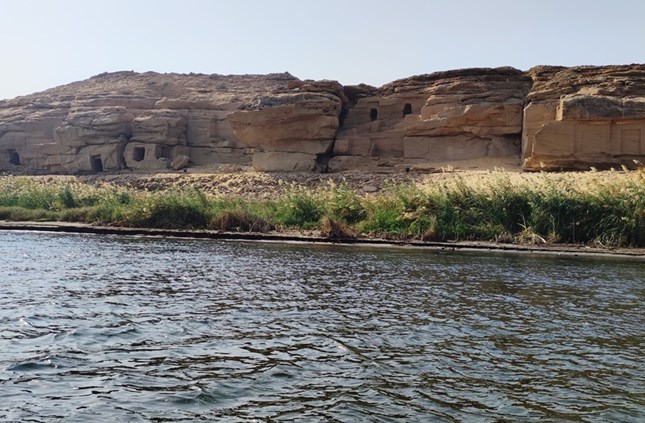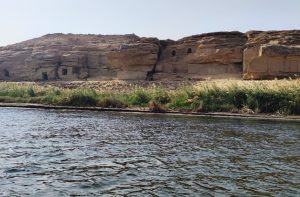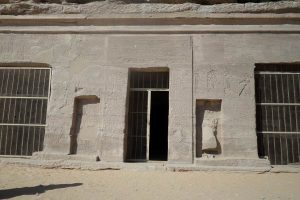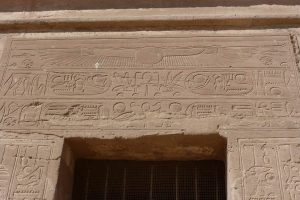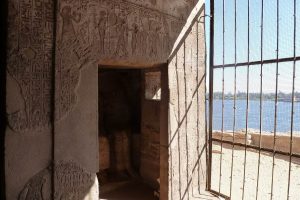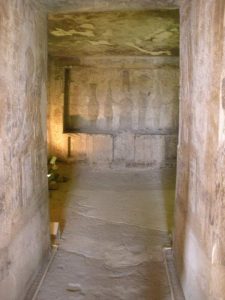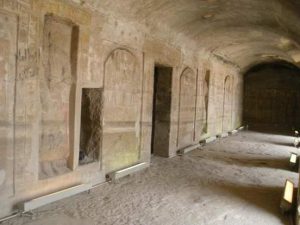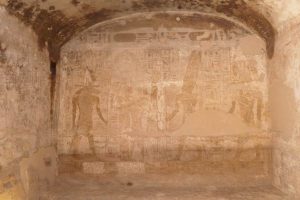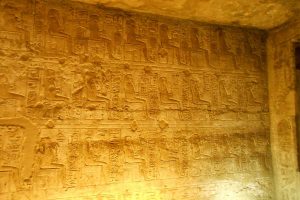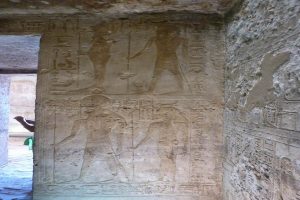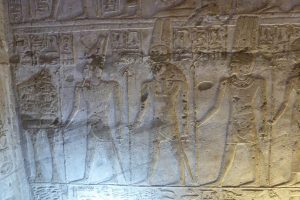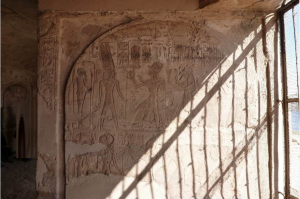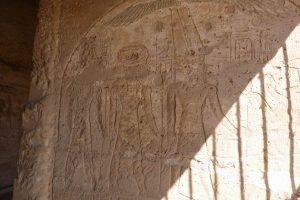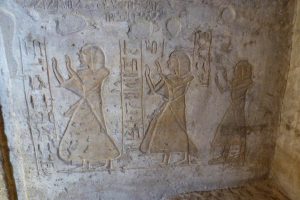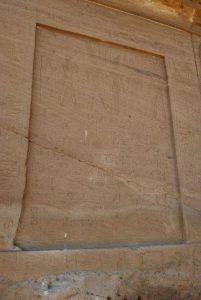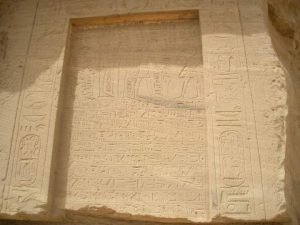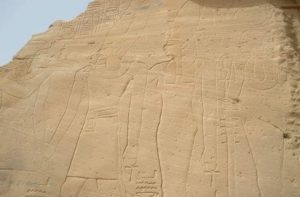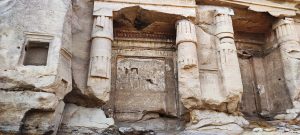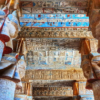Important Quarries
The ancient Egyptians were famous for using stones in the manufacture of statues, obelisks, and the construction of temples, tombs, and pyramids. Among the most famous of these types are:
• Granite from the Aswan quarries
• Limestone from the Tura quarries in Cairo
• Sandstone from Gebel el-Silsila
Gebel el-Silsila Quarry
Its use began since the Middle Kingdom, about 200 years BC, and is still used today. There are more than 100 quarries in the mountain from which sandstone is extracted. The quarry has preserved traces of the workers’ tools and their inscriptions until now. There is a temple carved in the rock in the area for King Horemheb . There are also 32 rock-cut chambers for senior officials in the New Kingdom from the reign of Queen Hatshepsut to the reign of King Thutmose III (around 1480-1425 BC). There are also a number of rock-cut chambers for the kings Seti I, his son Ramses II, and his grandson Merneptah (around 1294-1203 BC). There is also a large stela of King Ramses III from (around 1184-1153 BC). There is also a group of paintings and graffiti on the eastern bank of the Nile from all periods of ancient Egypt, from the pre-dynastic era to the Roman era. In 2015, a group of about 78 tombs from the New Kingdom was discovered. These tombs reveal to us that the workers were living in Gebel el-Silsila and not just a temporary residence. These tombs were simple, unadorned chambers carved into the rock, containing pottery, faience beads, amulets, bronze bracelets, and animal bones. Unfortunately, they were found in poor condition due to the rise in water levels. Excavating, preserving, studying, and understanding the contents of these tombs is important for understanding this unique site.
General View of the Gebel el-Silsila Sculptures on the Eastern Bank of the Nile.
A general view of the tombs of the workers of the New Kingdom discovered in 2015.
A general view of the tombs of the workers of the New Kingdom discovered in 2015.
The Temple of King Horemheb
Horemheb (around 1323-1295 BC) carved this temple into the rock. The temple’s facade has five openings separated by columns, with the central opening being the entrance. The royal names of Horemheb are carved around it. We enter a hall that opens onto the holy of holies.
Description of the Temple:
The middle entrance is the main entrance. We see a carving of a winged solar disk on it, and on either side of it are carvings of the names and titles of King Horemheb, and invocations for him.
Facade of the Temple of Horemheb
Scenes on the facade of the temple include a winged solar disk with the names and titles of King Horemheb beneath it.
The Transverse Hall
Its dimensions are 23 x 20 meters, with a vaulted ceiling in the form of a half-cylinder without any decorations. However, on the southern and northern walls, there is a protruding structure resembling a bench, about half a meter high and half a meter deep.
The Holy of Holies
Its dimensions are 4 x 3.5 meters. The ceiling is flat but lower than that of the transverse hall. On the western wall is a niche containing seven statues: Amun-Ra, Mut, and Khonsu in the middle, Sobek (the crocodile god), Thoth (the god of wisdom), Taweret (the goddess of childbirth and protection), and King Horemheb himself.
Important Inscriptions
The most important inscriptions depict the king’s victories over foreign lands, showing his victorious procession in Nubia. Some inscriptions depict the king’s celebration of victory, while others depict his coronation. One of the most beautiful scenes is that of the goddess Taweret breastfeeding King Horemheb on the western wall. After that, during the Ramesside period (Ramses II, Seti I, Merneptah, and Ramses III), they added scenes, paintings, and inscriptions celebrating their visits to this sacred site. In the Roman era, the chamber was used as a Christian church, as evidenced by the presence of many crosses.
Statues of the gods inside the holy of holies
Statues carved in the rock of the temple gods in the holy of holies
The holy of holies from the inside
Different scenes of the king worshipping the gods inside the holy of holies
Different scenes of the king worshipping the gods inside the holy of holies
Different scenes of the king worshipping the gods inside the holy of holies
Different scenes of the king worshipping the gods inside the holy of holies
Different scenes of the king worshipping the gods inside the holy of holies
Different scenes of the king worshipping the gods inside the holy of holies
Different scenes of the king worshipping the gods inside the holy of holies
Different scenes of the king worshipping the gods inside the holy of holies
The Royal Stelae
There are three royal stelae on a high rock on the bank of the Nile River.
The first stela
on the north, is for King Ramses V (around 1147-1143 BC). It is decorated with a scene showing the king offering sacrifices to the god Amun-Ra, his wife Mut, and their son Khonsu. Beneath the scene, the inscription mentions the most important works of this king and many of his titles.
depicts King Ramses V before the gods Amun-Ra, Mut, and Khonsu. Behind him, the gods Ptah and Ra-Hor Akhty are also present
The second stela
is for King Shoshenq I (around 945-924 BC). It shows the goddess Mut leading the king to the gods Amun-Ra, Ra-Hor Akhty, and Ptah. It is written on it that the king opened this part of the Gebel el-Silsila quarries. And we see a scene of the overseer of the works of King Shoshenq I in Thebes kneeling at the bottom of the stela.
King Shoshenq I before the Theban Triad
The third stela
is the most important and largest stela of King Ramses III (around 1184-1153 BC). It depicts the king offering Maat (the goddess of truth and justice) to the Theban Triad composed of Amun-Ra, Mut, and Khonsu.
Inscription of the Theban trinity of Amun-Ra and Mut-Khonsu, with Ramesses III presenting Maat in front of them
the Nile Stelae
The Nile was sacred to the ancient Egyptians because it brought them abundant goodness. It brought the water they drank and used for agriculture. With the Nile flood came silt, which was a natural fertilizer for agricultural land. The flood unified the Egyptians, leading them to establish villages and cities. The Egyptians, from ancient times until now, preferred to live on the banks of the Nile. Therefore, the Nile Valley in Egypt constitutes about 6%, but it is inhabited by 94% of Egypt’s population today. The Egyptians used to offer sacrifices to the god Hapi, the god of the Nile, at the time of the flood. King Seti I, began carving Nile scenes in Gebel el-Silsila to commemorate the offering of sacrifices to the god Hapi. His son, Ramses II, and his grandson, Merneptah (around 1294-1203 BC), continued this tradition. Ramses III (around 1184-1153 BC) added a large stela of his own. The texts on the stelae request from the god Hapi a suitable and abundant flood that does not pose a danger to Egypt. They also ask him for plenty of fish and birds with the flood. The Egyptians believed that the flood was what fertilized the land, producing abundant crops, which were the basis of life for the Egyptian people.
scene for the Nile Stelae

